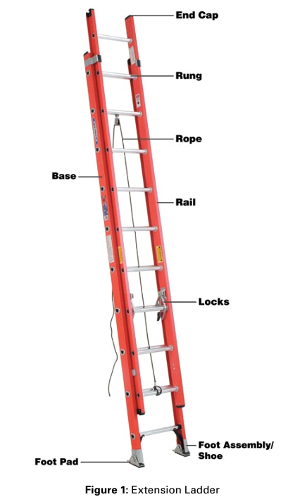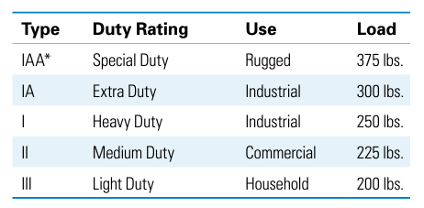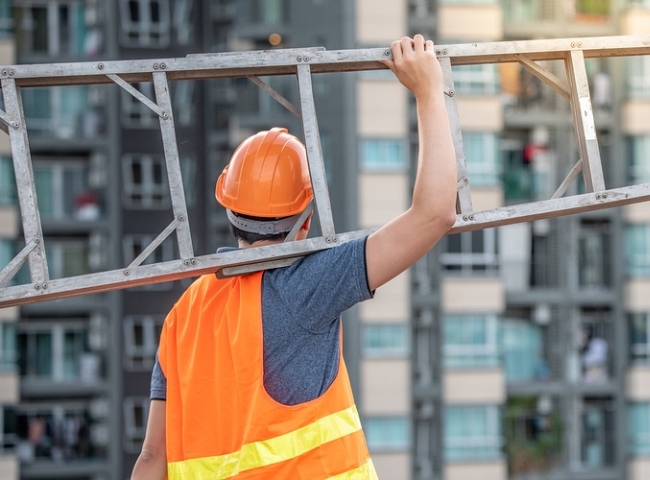What is an Extension Ladder?
Also known as “portable ladders,” extension ladders usually have two sections that operate in brackets or guides allowing for adjustable lengths. (See Figure 1, below.) Because extension ladders are not self-supporting, they require a stable structure that can withstand the intended load.

• Use a ladder that can sustain at least four times the maximum intended load, except that each extra-heavy-duty type 1A metal or plastic ladder shall sustain at least 3.3 times the maximum intended load. Also acceptable are ladders that meet the requirements set forth in Appendix A of Subpart X. Follow the manufacturer’s instructions and labels on the ladder. To determine the correct ladder, consider your weight plus the weight of your load. Do not exceed the load rating and always include the weight of all tools, materials and equipment.
• A competent person must visually inspect all extension ladders before use for any defects such as: missing rungs, bolts, cleats, screws and loose components. Where a ladder has these or other defects, it must be immediately marked as defective or tagged with “Do Not Use” or similar language.
• Allow sufficient room to step off the ladder safely. Keep the area around the bottom and the top of the ladder clear of equipment, materials and tools. If access is obstructed, secure the top of the ladder to a rigid support that will not deflect, and add a grasping device to allow workers safe access.
• Set the ladder at the proper angle. When a ladder is leaned against a wall, the bottom of the ladder should be one-quarter of the ladder’s working length away from the wall. For access to an elevated work surface, extend the top of the ladder three feet above that surface or secure the ladder at its top.
• Before starting work, survey the area for potential hazards, such as energized overhead power lines. Ladders shall have nonconductive side rails if they are used where the worker or the ladder could contact exposed energized electrical equipment. Keep all ladders and other tools at least 10 feet away from any power lines.
• Set the base of the ladder so that the bottom sits securely and so both side rails are evenly supported. The ladder rails should be square to the structure against which it is leaning with both footpads placed securely on a stable and level surface.
• Secure the ladder’s dogs or pawls before climbing.
• When using a ladder in a high-activity area, secure it to prevent movement and use a barrier to redirect workers and equipment. If the ladder is placed in front of a door, always block off the door.
To prevent workers from being injured due to falls from various types of ladders, including extension ladders and stepladders, employers are encouraged to adopt the following practices:
Safe Extension Ladder Use—DO:
- Maintain a 3-point contact (two hands and a foot, or two feet and a hand) when climbing/descending a ladder.
- Face the ladder when climbing or descending.
- Keep the body inside the side rails.
- Use extra care when getting on or off the ladder at the top or bottom.
- Avoid tipping the ladder over sideways or causing the ladder base to slide out.
- Carry tools in a tool belt or raise tools up using a hand line. Never carry tools in your hands while climbing up/down a ladder.
- Extend the top of the ladder three feet above the landing.
- Keep ladders free of any slippery materials.
Safe Extension Ladder Use—DON’T:
- Place a ladder on boxes, barrels, or unstable bases.
- Use a ladder on soft ground or unstable footing.
- Exceed the ladder’s maximum load rating.
- Tie two ladders together to make them longer.
- Ignore nearby overhead power lines.
- Move or shift a ladder with a person or equipment on the ladder.
- Lean out beyond the ladder’s side rails.
- Use an extension ladder horizontally like a platform.
PROVIDE the Right Extension Ladder for the Job with the Proper Load Capacity. Select a ladder based on the expected load capacity (duty rating), the type of work to be done and the correct height. There are five categories of ladder duty ratings.

Safe Stepladder Use—DO:
- Read and follow all the manufacturer’s instructions and labels on the stepladder.
- Look for overhead power lines before handling or climbing a ladder.
- Maintain a 3-point contact (two hands and a foot, or two feet and a hand) when climbing/descending a ladder.
- Stay near the middle of the ladder and face the ladder while climbing up/down.
- Use a barricade to keep traffic away from the ladder.
- Keep ladders free of any slippery materials.
- Only put ladders on a stable and level surface that is not slippery.
Safe Stepladder Use—DON’T:
- Use stepladders for a purpose other than that for which they were designed.
- Use a stepladder with spreaders unlocked.
- Use the top step or cap as a step.
- Place a ladder on boxes, barrels or other unstable bases.
- Move or shift a ladder with a person or equipment on the ladder.
- Use cross bracing on the rear of stepladders for climbing.
- Paint a ladder with opaque coatings.
- Use a damaged ladder.
- Leave tools/materials/equipment on stepladder.
- Use a stepladder horizontally like a platform.
- Use a metal stepladder near power lines or electrical equipment.
Spencer-SHE has been providing Safety, Health, and Environmental Compliance Guidance since 1980. Our team can train workers to use ladders safely. Employers must train each worker to recognize and minimize ladder-related hazards.
Contact us here to help you to develop and maintain a safe and healthy workforce.
Sources:
Photo: https://osha4you.com/ladders/ladder-safety-dos-and-donts/
Photo: https://www.osha.gov/Publications/OSHA3660.pdf

